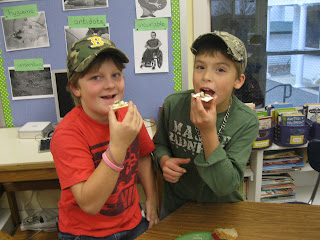This does not mean, however, that kids wouldn't have been thrilled to witness the cooking disaster that took place on my stove about an hour ago. It's so good that I'm going to digress and share it here:
I was finishing off a batch of a lovely chicken and root vegetable stew that is both enjoyed by all members of my family and brilliant in that it uses up all the weird root vegetables accumulating in the fridge from our winter CSA. I make it about once a month to clear out all the rutabaga and turnips. The cooked chicken and veggies had been removed from the pot, leaving only the seasoned stock. I added two tablespoons of cornstarch to some light cream and dumped it into the stock to thicken it. To my surprise, the liquid on the stove foamed in a way that I'd never seen before. Baffled, I looked across the counter and realized I'd mistakenly grabbed the box of baking soda out of the cabinet instead of the cornstarch.
The happy ending of this mix up is that other than making the sauce foamy, the baking soda didn't ruin the stew. Even if it had, the veggies and chicken were safely out of harms way in a bowl on the countertop. And to my amusement, when I Googled "accidentally used baking soda instead of cornstarch", I only had to type in the first four words before the rest of the phrase popped up. Apparently I'm not the only frazzled cook out there...
While I'm sure that, given the addition of twenty-two fifth and sixth graders, I could have turned this multi-ingredient bonanza into some sort of chemistry lesson, it's just as easy to teach kids about food with a single ingredient.
Let's get back to Friday afternoon.
We've been studying the nervous system for the past two weeks, and one of the unit's essential questions is "How can I keep my body systems healthy?" My intention is to introduce foods and recipes that can have a positive impact on the system under study. Foods rich in omega 3s are good for brain development and health, and these include many fatty fishes, nuts, and eggs. My classroom is nut free and most kids have eggs in their diets. Many families in this community hunt and fish, yet I was correct in assuming that most kids had not ever eaten sardines.
My dad has always been a big sardine eater, but they only became a regular part of my diet a couple years ago when I was trying to reduce my cholesterol without going on medication. I started eating sardines on toast on the nights we made grilled cheese for the kids. (Those omega 3s are also good for lowering cholesterol.) Sardines are not only high in omega 3s, but also low in mercury and other contaminants since they are so low on the food chain. They are also affordable and accessible, making them a good food for anyone to know about.
We started off by reading a greatly condensed version of this article. Then I told kids that each pair of kids would get a single sardine to split in half. (A student who fishes a lot informed me the proper term would be 'fillet.') There was a lot of interest in removing the spine! Then kids tasted a bit, with varied reactions. As this investigation was going on, Su was getting plates of crackers, bread, butter and cream cheese ready for each table.
Kids started experimenting with various combinations, and most pairs asked for a second sardine to split up and eat as well. The air smelled fishy, but there was almost no wasted food in the trash can.
I collected dirty dishes and silverware in a bin, having decided that these dishes deserved a run through the dishwasher in the kitchen. Score one point for easy clean up! Then we shared reactions. Almost everyone had tried the sardines and almost everyone wanted to talk about what they thought about the little fishies. I informed kids where you can find sardines and how much they cost. I also mentioned that you can find them packaged in sauces. My dad likes the mustard sauce in particular. When I mentioned this, some people went, "Ooooh" in a I'm-not-sure-that's-a-good-idea sort of way, but at least one boy's face lit up and he said, "I wanna try those!"
When I first started cooking with my class just over a year ago, my goal was to help students learn more about how what they eat can be part of a healthy lifestyle. What we've cooked has almost always been integrated into the science and social studies curriculum. Along the way, it's also become my mission to expose them to new foods they didn't already know about. Yesterday, without any measuring, mixing, or heating, I accomplished all three goals. And all we had to do was open a couple of cans.





No comments:
Post a Comment